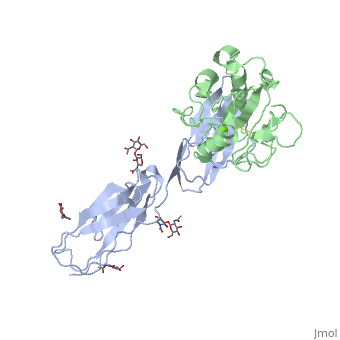Intercellular adhesion molecule
From Proteopedia
(Difference between revisions)
(New page: <StructureSection load='1mq8' size='340' side='right' caption='Structure of human ICAM-1 domains 1-2 complex with LFA-1 (PDB code 1mq8).' scene=''> == Function == '''Intercellular a...) |
|||
| (13 intermediate revisions not shown.) | |||
| Line 1: | Line 1: | ||
| - | + | <StructureSection load='1mq8' size='340' side='right' caption='Structure of glycosylated human ICAM-1 domains 1-2 (grey) complex with LFA-1 (green) and Mg+2 ion (green) (PDB code [[1mq8]]).' scene=''> | |
| - | <StructureSection load='1mq8' size='340' side='right' caption='Structure of human ICAM-1 domains 1-2 complex with LFA-1 (PDB code [[1mq8]]).' scene=''> | + | |
== Function == | == Function == | ||
| - | '''Intercellular adhesion molecule''' (ICAM) is part of the immunoglobulin superfamily. ICAM binds to LFA-1 and macrophage-1 antigen during inflammation. ICAM contains 5 Ig-like domains. | + | '''Intercellular adhesion molecule''' (ICAM) is part of the immunoglobulin superfamily. ICAM binds to leukocyte function associated molecule 1 (LFA-1) and macrophage-1 antigen during inflammation<ref>PMID:8834767</ref>. ICAM contains 5 Ig-like domains. |
| + | |||
| + | *'''ICAM-1''' is Ig-like cell adhesion molecule which has a role in inflammatory processes and in T-cell mediated host defines system. | ||
| + | *'''ICAM-2''' mediates adhesive interactions important for antigen-specific immune response. | ||
| + | *'''ICAM-3''' acts as recognition receptor in the phagocytosis of macrophages in engulfment of apoptotic neutrophils<ref>PMID:23775590</ref>. | ||
| + | *'''ICAM-5''' has 2 types of binding activities: binding between neutrons and binding between neuron and leukocytes. | ||
== Disease == | == Disease == | ||
| + | ICAM mutation is involved in multiple sclerosis<ref>PMID:12590979</ref>. | ||
| - | + | </StructureSection> | |
| - | + | ||
| - | + | ||
==3D structures of intercellular adhesion molecule== | ==3D structures of intercellular adhesion molecule== | ||
Updated on {{REVISIONDAY2}}-{{MONTHNAME|{{REVISIONMONTH}}}}-{{REVISIONYEAR}} | Updated on {{REVISIONDAY2}}-{{MONTHNAME|{{REVISIONMONTH}}}}-{{REVISIONYEAR}} | ||
| + | {{#tree:id=OrganizedByTopic|openlevels=0| | ||
| - | + | *ICAM-1 (CD54) | |
| - | + | ||
| - | + | ||
| - | + | ||
| - | + | **[[1iam]], [[1ic1]], [[1d3l]] – hICAM N terminal domain – human<br /> | |
| + | **[[1p53]] – hICAM domain 3-5<br /> | ||
| - | + | *ICAM-1 complexes | |
| - | + | ||
| - | + | ||
| - | + | ||
| - | + | ||
| - | + | **[[1d3e]], [[1d3i]] – hICAM N terminal domain + rhinovirus coat proteins - CryoEM<br /> | |
| + | **[[7bg7]] – hICAM + rhinovirus polyproteins - CryoEM<br /> | ||
| + | **[[1mq8]] – hICAM domain 1-2 + LFA-1<br /> | ||
| + | **[[3tcx]] – hICAM domain 1 + LFA-1<br /> | ||
| + | **[[6eit]] – hICAM domain 1-2 + coxsakievirus coat proteins - CryoEM<br /> | ||
| + | **[[1z7z]] – hICAM domain 1-5 + coxsakievirus coat proteins - CryoEM<br /> | ||
| + | **[[2oz4]] – hICAM domain 4 + antibody<br /> | ||
| + | **[[5mza]], [[6s8u]] – hICAM residues 28-212 + erythrocyte membrane protein 1<br /> | ||
| - | + | *ICAM-2 | |
| - | + | **[[1zxq]] – hICAM extracellular domain <br /> | |
| - | + | *ICAM-3 | |
| - | + | **[[1t0p]] – hICAM N terminal domain + LFA-1<br /> | |
| - | + | *ICAM-5 | |
| + | **[[3bn3]] – hICAM N terminal domain + LFA-1<br /> | ||
| + | **[[4oi9]], [[4oia]], [[4oib]] – hICAM domain D1-D4<br /> | ||
| + | }} | ||
== References == | == References == | ||
Current revision
| |||||||||||
3D structures of intercellular adhesion molecule
Updated on 04-July-2024
References
- ↑ van de Stolpe A, van der Saag PT. Intercellular adhesion molecule-1. J Mol Med (Berl). 1996 Jan;74(1):13-33. PMID:8834767
- ↑ Kristóf E, Zahuczky G, Katona K, Doró Z, Nagy É, Fésüs L. Novel role of ICAM3 and LFA-1 in the clearance of apoptotic neutrophils by human macrophages. Apoptosis. 2013 Oct;18(10):1235-51. PMID:23775590 doi:10.1007/s10495-013-0873-z
- ↑ Nejentsev S, Laaksonen M, Tienari PJ, Fernandez O, Cordell H, Ruutiainen J, Wikstrom J, Pastinen T, Kuokkanen S, Hillert J, Ilonen J. Intercellular adhesion molecule-1 K469E polymorphism: study of association with multiple sclerosis. Hum Immunol. 2003 Mar;64(3):345-9. PMID:12590979

